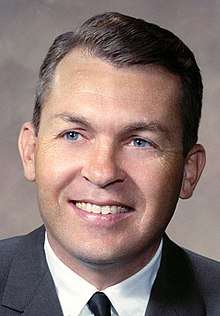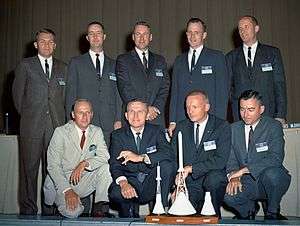Elliot See
| Elliot M. See Jr. | |
|---|---|
 Official portrait taken in 1964 | |
| NASA Astronaut | |
| Nationality | American |
| Born |
July 23, 1927 Dallas, Texas, U.S. |
| Died |
February 28, 1966 (aged 38) St. Louis, Missouri, U.S. |
Resting place | Arlington National Cemetery[1] |
Other names | Elliot McKay See Jr. |
Other occupation |
Test pilot, engineer, naval aviator |
|
UT Austin USMMA, B.S. 1949 UCLA, M.S. 1962 | |
| Rank |
|
| Selection | 1962 NASA Group 2 |
| Missions | None |
Elliot McKay See Jr. (July 23, 1927 – February 28, 1966) was an American engineer, naval aviator, test pilot, and NASA astronaut. He was selected for NASA's second group of astronauts in 1962.[2] See was chosen as the prime command pilot for what would have been his first space flight, Gemini 9. He was killed with Charles Bassett, his intended Gemini 9 crewmate, in a 1966 NASA trainer jet crash at the St. Louis, Missouri McDonnell Aircraft plant, where they were to take two weeks of space rendezvous simulator training.
Biography
Early life and education
See was born in Dallas, Texas on July 23, 1927, and attended Highland Park High School, from which he graduated in 1945.[3]:36 See was active in the Boy Scouts of America and earned the rank of Eagle Scout.[4] After initially attending The University of Texas where he was a member of Phi Kappa Psi, See received an appointment to the United States Merchant Marine Academy, from which he graduated with a Bachelor of Science degree in 1949.[3]:37 He later obtained a Master of Science degree in Engineering from UCLA in 1962.[3]:44
He married to Marilyn Denahy See on September 30, 1954.[3]:41 The couple had three children: Sally, born in 1956; Carolyn, born in 1957; and David, born in 1962.[5]
Career
Navy service and General Electric
— See's feelings about being selected as an astronaut[3]
After See graduated, he worked briefly for Lykes Brothers Steamship Company. See applied for General Electric, the same company his father worked for, and began work September 1, 1949. He began work in Boston at their Aircraft Gas Turbine Division. When the division moved to Cincinnati, Ohio, See made the move as well. See met his future wife, Mary Denahy, in Cincinnati. See and a roommate purchased a Luscombe Silvaire, which they would sometimes take on cross country trips.[3]:39-41
In 1952, while taking Marilyn on a trip in his airplane, the engine began to sputter. See attempted to land the aircraft on a short, unimproved field, but the tail wheel snagged a power line and forced the aircraft into the ground. See suffered deep cuts to his face which required plastic surgery, and Marilyn escaped the crash with only minor injuries.[3]:41
He later became a flight engineer at the Evendale, Ohio plant. A year later he was called up from the reserves to active service. See was assigned to Fighter Squadrоn VF-144 for 16 months, based out of San Diego. He spent four weeks temporarily assigned to El Centro for training.[3]:41
See was then assigned to the USS Boxer, an aircraft carrier in the Mediterranean. His squadron flew the F9F-5 Panther. While on the USS Boxer, he primarily focused on line maintenance, but also became proficient at landing on the carrier.[3]:42
He worked as a Naval Aviator from 1953 to 1956. See rejoined General Electric in 1956 after his tour of duty.[3]:42 He served as a project pilot for the J79-8 engine development program used in the F4H aircraft. See conducted powerplant flight tests on the J-47, J-73, J-79, CJ805, and CJ805 aft-fan engines. This work involved flying in F-86, XF4D, F-104, F11F-1F, RB-66, F4H, and T-38 aircraft.[2]
NASA

In 1962, See was selected to be in NASA's second group of astronauts, known as The New Nine. He helped develop guidance and navigation systems.[6] He served as backup pilot for Gemini 5 with Neil Armstrong serving as backup command pilot. The two were the first civilians selected for a potential spaceflight.[7] See was a CAPCOM in Houston during the Gemini 7/6A rendezvous mission in December 1965.
He was in line to fly as prime crew Pilot (second seat) for Gemini 8, but was promoted to be the Command Pilot (first seat) of Gemini 9.[2][8]:138,168 According to chief astronaut Deke Slayton's autobiography, Slayton did not assign See to Gemini 8 because he did not consider him physically capable of performing an extravehicular activity. Slayton further stated that he assigned See to Gemini 9 because he had become "sentimental" about getting him a flight, calling it "a bum decision."[9][8]:167,168
Death

See and fellow astronaut Charles Bassett, assigned as Pilot for Gemini 9, were killed before their mission on February 28, 1966, when their T-38 trainer jet crashed into McDonnell Aircraft Building 101, known as the McDonnell Space Center, located 1,000 feet (300 m) from Lambert Field airport in St. Louis, Missouri. Building 101 was where the Gemini spacecraft was built, and they were going there to do rendezvous training for two weeks in a simulator, along with their backup crew. See and Bassett died within 500 feet (150 m) of their spacecraft. Both were buried in Arlington National Cemetery.[1][10][11]
A NASA investigative panel later concluded that pilot error caused by poor visibility due to bad weather had been the principal cause of the accident. The panel concluded that See was flying too low to the ground during his second approach, probably as a result of the poor visibility. Slayton would later express doubts about See's flying ability, claiming that See flew too slowly and "wasn't aggressive enough."[8]
The mission was launched three months later, in early June, as Gemini 9A. The shuffling of the Gemini prime and backup crew assignments that occurred after the deaths of See and Bassett impacted the crew selections for some of the early Apollo manned missions.[8]
He logged more than 3,900 hours flying time, including more than 3,300 hours in jet aircraft.[2]
Legacy

His name is inscribed on the Fallen Astronaut plaque placed on the Moon by Apollo 15 in 1971.[12] See's name is listed on the Space Mirror Memorial located at the John F. Kennedy Space Center Visitor Complex, which was dedicated in 1991.[13] A family-approved account of See's life and career appears in the 2003 book Fallen Astronauts by space historians Colin Burgess and Kate Doolan.[3] See was honored as a Distinguished Alumnus of Highland Park High School in 2010.[14]
See was a member of the Society of Experimental Test Pilots, and an associate fellow of the American Institute of Aeronautics and Astronautics.[2]
See also
References
- 1 2 "Elliott M. See, Jr., Commander, United States Navy Reserve". Arlington National Cemetery. Retrieved June 25, 2016.
- 1 2 3 4 5 "Astronaut Bio: Elliot M. See Jr". NASA Johnson Space Center. February 1966. Retrieved October 9, 2016.
- 1 2 3 4 5 6 7 8 9 10 11 Burgess, Colin; Doolan, Kate (October 1, 2003). Fallen Astronauts: Heroes Who Died Reaching for the Moon, Revised Edition. Bibson Books. ISBN 978-0803262126. Retrieved June 26, 2016.
- ↑ "Astronauts and the BSA" (PDF). Boy Scouts of America. Retrieved June 25, 2016.
- ↑ "Elliot M. See Jr". The Astronauts Memorial Foundation, The Center for Space Education. Retrieved October 9, 2016.
- ↑ "Remembering NASA Astronauts Elliot See and Charles Bassett". NASA. February 26, 2016. Retrieved February 1, 2018.
- ↑ "7-Day Space Flight Astronauts Selected". Tampa Bay Times. February 9, 1965. p. 2. Retrieved February 1, 2018 – via Newspapers.com.
- 1 2 3 4 Slayton, Donald K. "Deke"; Cassutt, Michael (1994). Deke! U.S. Manned Space: From Mercury to the Shuttle (1st ed.). New York: Forge (St. Martin's Press). ISBN 0-312-85503-6. LCCN 94-2463. OCLC 29845663.
- ↑ Burgess, Colin; Doolan, Kate (2016). Fallen Astronauts: Heroes Who Died Reaching for the Moon, Revised Edition. U of Nebraska Press. p. 110. ISBN 9780803285996.
- ↑ "Charles Arthur Bassett II". Arlington National Cemetery. Retrieved October 9, 2016.
- ↑ McMichael, W. Pate (May 2006). "Losing The Moon". St. Louis Magazine. St. Louis, MO. Retrieved October 9, 2016.
- ↑ Eveleth, Rose (January 7, 2013). "There Is a Sculpture on the Moon Commemorating Fallen Astronauts". Smithsonian. Retrieved October 9, 2016.
- ↑ "The Astronauts Memorial Foundation Space Mirror Memorial". The Astronauts Memorial Foundation. Retrieved October 9, 2016.
- ↑ "Highland Park High School Distinguished Alumni List". Highland Park High School Alumni Association. Archived from the original on September 13, 2012. Retrieved May 7, 2012.
Bibliography
- Codex Regius (2014). The Forgotten Astronauts: A rarely told Chapter of American Spaceflight History. Wiesbaden: CreateSpace. ISBN 1-4996-1012-2.
External links
| Wikimedia Commons has media related to Elliot See. |